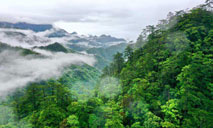A ranger's devotion to bird conservation at Xinjiang park
URUMQI, May 26 (Xinhua) -- Before the crack of dawn each day, Ayimurat Dawuletbek can be seen on the lakeside of a national wetland park in northwest China's Xinjiang Uygur Autonomous Region. He moors his boat between reed marshes and sets up a monocular telescope and a camouflaged digital SLR camera.
One day, having crouched for almost an hour, he focused his camera on a flock of white-headed ducks landing on the water some 100 meters away, waiting for the perfect time to photograph them. But he soon began experiencing back pain and a loss of feeling in his legs.
"I can't get close to them as the parent birds always keep a watchful eye over their broods, which are too immature to fly. If I get too close, they will feel threatened and move from their carefully chosen home," he said. "We shouldn't disturb them."
Ayimurat Dawuletbek, 36, is a ranger, bird watcher and shutterbug at the Ulunggur Lake National Wetland Park in Fuhai County, northern Xinjiang's Altay Prefecture.
The park, covering over 120,000 hectares, boasts lakes, marshes and rivers, thus providing abundant food and an ideal location for migratory birds and birds that prefer to remain throughout the year.
He began working as a ranger in 2016 after seeing a job advertisement and successfully earning the role.
Without an in-depth knowledge of birds, he found it difficult to recognize them during his first few years.
"Every time a bird hovered near me, I photographed it with my mobile phone and looked it up in a bird encyclopedia after a long day at work. I sometimes sought help from experts," he recalled.
Ayimurat Dawuletbek now spends most of his time wandering the park, keeping the environment clean, helping visitors with any troubles and rescuing injured birds.
To monitor the birds, he drives his pickup across frozen lakes during the winter and scatters dried corn over known feeding locations to help them get by.
"Although I drill into the ice to measure its thickness every time before I depart, to make sure it's safe, I'm still a little worried."
In late January this year, he received a phone call from a tourist notifying him that a kestrel had crashed into glass while hunting for prey and fallen to the ground. He rushed to the site and found that the stunned bird's right wing was slightly injured.
He returned with it and provided treatment. Days later, he released the bird back into the wild.
Park authorities have taken a variety of protection measures in recent years. A patrol team consisting of 18 rangers was established and eight monitoring stations were built.
Since 2015, governments at various levels in Xinjiang have invested some 120 million yuan (about 18.72 million U.S. dollars) in the ecological conservation of the wetland park.
Thanks to the joint efforts, a total of 269 bird species had been spotted in the park by 2020, according to Zhang Yihai, head of the park's administration.
Zhang said that 162 white-headed ducks, a bird species under first-class national protection, were spotted in the park in 2020, an increase of 157 from 2017.
"The increase indicates that the park's environmental improvements are being favored by more and more birds, and its biodiversity is getting richer," said Zhang.
Six years into his job, Ayimurat Dawuletbek has traveled almost every inch of the park.
He is now capable of identifying some 130 bird species by appearance and recognizing more than 50 species by their distinctive chirps.
"I'll continue to make contributions to the conservation of these birds," he said.
Photos
Related Stories
Copyright © 2021 People's Daily Online. All Rights Reserved.










